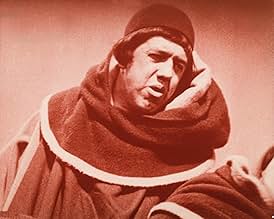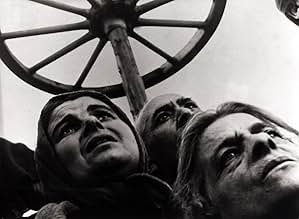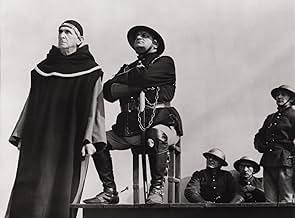IMDb RATING
8.1/10
66K
YOUR RATING
In 1431, Jeanne d'Arc is placed on trial on charges of heresy, and the ecclesiastical jurists attempt to force her to recant her claims of holy visions.In 1431, Jeanne d'Arc is placed on trial on charges of heresy, and the ecclesiastical jurists attempt to force her to recant her claims of holy visions.In 1431, Jeanne d'Arc is placed on trial on charges of heresy, and the ecclesiastical jurists attempt to force her to recant her claims of holy visions.
- Director
- Writers
- Stars
- Awards
- 4 wins & 1 nomination total
Maria Falconetti
- Jeanne d'Arc
- (as Mlle Renée Falconetti)
Eugene Silvain
- Évêque Pierre Cauchon (Bishop Pierre Cauchon)
- (as Eugène Silvain)
Louis Ravet
- Jean Beaupère
- (as Ravet)
Armand Lurville
- Juge (Judge)
- (as André Lurville)
Jean Aymé
- Juge (Judge)
- (uncredited)
Gilbert Dacheux
- Juge (Judge)
- (uncredited)
Gilbert Dalleu
- Jean Lemaître
- (uncredited)
Paul Delauzac
- Martin Ladvenu
- (uncredited)
Dimitri Dimitriev
- Juge (Judge)
- (uncredited)
- Director
- Writers
- All cast & crew
- Production, box office & more at IMDbPro
Summary
Reviewers say 'The Passion of Joan of Arc' is celebrated for its innovative close-ups, emotional intensity, and pioneering silent film techniques. Renée Falconetti's performance is lauded for its subtlety and expressiveness. The film delves into themes of faith, power, and human spirit, contrasting Joan's purity with her accusers' corruption. Critics praise Dreyer's meticulous direction and the film's historical significance. Some find the silent format and close-ups challenging, yet it remains a landmark in cinematic achievement.
Featured reviews
One of the last great silent films made during the advent of sound, Carl-Theodor Dreyer's The Passion of Joan of Arc is a haunting, riveting portrait of the historical martyr based on documentation from the original trial. Focusing primarily on the series of courtroom examinations that doomed the young warrior, the film gloriously employs vivid close-ups to accentuate the ordinariness (while at the same time exaggerating the most grotesque qualities) of Joan's inquisitors. Maria Falconetti is unforgettable as Joan, perfectly distilling the pain, terror, and saintliness required by what is probably one of the most demanding roles an actor could attempt. The consequence of Joan's conviction -- her burning at the stake -- allows Dreyer to hammer home his exquisite visual motif balancing erotic corporeality with transcendent spirituality.
If you'll pardon the rambling, here are my thoughts immediately after watching this on DVD an hour ago.......
THE STORY - Many of the times, while watching this for the first time, I thought this was almost the re-enactment of Jesus' last day, seeing the phony trial, the trumped-up charges He endured by legalistic, power-hungry religious leaders of the day who had no clue who God is, and then the tragic end to the central character. Apparently, there were a lot of similarities to Joan of Arc's last day and of Christ's day. However, here it's the Catholic leaders who are the 'bad guys' while in Jesus' time it was the Pharisees and the Sanhedrin. Also, with Joan's story here, she is portrayed far differently in her ordeal than Christ did, the latter taking everything in stride stoically while Joan, without any physical beating, still cried constantly and signed some paper in a moment of weakness (although she later recants that, which costs the woman her life.)
Anyway, about this film:
THE GOOD - Wow, what incredible direction and photography. Scene after scene is pretty amazing and especially so when you consider this was made about 80 years ago! I would like to see the same director and photographer doing work with today's technology.
The expressions on Maria Falconetti's face throughout the film are memorable. A sadder, more pained look on Joan of Arc - or anyone else's - I have not seen in a motion picture. She also must have set a record that still stands for the most tears shed by one person in a movie! The woman's eyes were like faucets.
All of the faces in here - and the film is mostly a series of facial closeups - are amazing and kudos to Criterion for making a DVD that showed these faces with a clear picture and amazing detail. Director Carl Theodor Dreyer's camera angles still look innovative today. He and Orson Welles seem to share the same love of this kind of photography. I found myself numerous times just shaking my head in admiration for how these characters were photographed.
Another big plus for this film was the addition of "The Voices of Light." They made the music score in here fantastic. I can't recall too many films in which I have been so impressed with a soundtrack. The DVD gives you the option of watching this film with or without that audio. I strongly recommend viewers to take the audio.
Finally, the story itself is memorable, with a powerful ending.
THE BAD - I have to make these comments to be fair and honest. It's not hard to understand why many people will find this film almost impossible to sit through, especially those with no emotional or spiritual involvement with the story. That is because it is extremely slow and repetitive. Shot-after-shot of just Falconetti agonizing or crying and weird-looking men staring at her. If you aren't a devotee of cinematography, this movie could be extremely boring after about 10 minutes.
As powerful as the story is, it isn't a movie I would recommend for most people. I think most folks - of any age, frankly - would be turned off after 20 minutes. I understand that. As mentioned, this is not an easy film to view. This might be the longest 80-minute movie you'll ever see, if you aren't into it.
OVERALL - Visually and audibly: an astounding movie and one I am glad to have finally watched. If I was wishing to get into the movie business and wanted to learn how to shoot films, this would be a film I would study numerous times. Otherwise, one viewing is plenty. I can only recommend this film to a very select audience.
THE STORY - Many of the times, while watching this for the first time, I thought this was almost the re-enactment of Jesus' last day, seeing the phony trial, the trumped-up charges He endured by legalistic, power-hungry religious leaders of the day who had no clue who God is, and then the tragic end to the central character. Apparently, there were a lot of similarities to Joan of Arc's last day and of Christ's day. However, here it's the Catholic leaders who are the 'bad guys' while in Jesus' time it was the Pharisees and the Sanhedrin. Also, with Joan's story here, she is portrayed far differently in her ordeal than Christ did, the latter taking everything in stride stoically while Joan, without any physical beating, still cried constantly and signed some paper in a moment of weakness (although she later recants that, which costs the woman her life.)
Anyway, about this film:
THE GOOD - Wow, what incredible direction and photography. Scene after scene is pretty amazing and especially so when you consider this was made about 80 years ago! I would like to see the same director and photographer doing work with today's technology.
The expressions on Maria Falconetti's face throughout the film are memorable. A sadder, more pained look on Joan of Arc - or anyone else's - I have not seen in a motion picture. She also must have set a record that still stands for the most tears shed by one person in a movie! The woman's eyes were like faucets.
All of the faces in here - and the film is mostly a series of facial closeups - are amazing and kudos to Criterion for making a DVD that showed these faces with a clear picture and amazing detail. Director Carl Theodor Dreyer's camera angles still look innovative today. He and Orson Welles seem to share the same love of this kind of photography. I found myself numerous times just shaking my head in admiration for how these characters were photographed.
Another big plus for this film was the addition of "The Voices of Light." They made the music score in here fantastic. I can't recall too many films in which I have been so impressed with a soundtrack. The DVD gives you the option of watching this film with or without that audio. I strongly recommend viewers to take the audio.
Finally, the story itself is memorable, with a powerful ending.
THE BAD - I have to make these comments to be fair and honest. It's not hard to understand why many people will find this film almost impossible to sit through, especially those with no emotional or spiritual involvement with the story. That is because it is extremely slow and repetitive. Shot-after-shot of just Falconetti agonizing or crying and weird-looking men staring at her. If you aren't a devotee of cinematography, this movie could be extremely boring after about 10 minutes.
As powerful as the story is, it isn't a movie I would recommend for most people. I think most folks - of any age, frankly - would be turned off after 20 minutes. I understand that. As mentioned, this is not an easy film to view. This might be the longest 80-minute movie you'll ever see, if you aren't into it.
OVERALL - Visually and audibly: an astounding movie and one I am glad to have finally watched. If I was wishing to get into the movie business and wanted to learn how to shoot films, this would be a film I would study numerous times. Otherwise, one viewing is plenty. I can only recommend this film to a very select audience.
10zeph-3
I saw this film for the very first time last week and was so tremendously captivated by it that I needed to share this rapture. The innovative camera-angles, the close-ups revealing pain and spirituality. It elevates the human condition and the Art of film. I would love to be able to go on into the whys or hows or technicalities. But my words couldn't do the film justice for the imagery still overwhelms me.
This film almost leads one to believe that sound betrays the emotion the eyes capture. Just as the blind develop hearing far better than the average, the deaf develop a keen sense of sight. I am convinced that a lack of dialogue forces us to read the language of the face and body, a verbage unmatched in beauty and nuance. Though the accompanying musical piece (be careful not to identify it as a score), so deliciously inspired by the film, enhances the visual playground; it is the actors' faces that comprise this tour de force. Ms. Falconetti shifts from worry and doubt to unabashed conviction in a single shot, giving the viewer the luck of seeing one's thoughts in progress. She needs no response to the interrogation, it's all in her face. Renee is not superficially beautiful and the lack of make-up only reinforces how bare Joan is, but it is the uncanny ability of an incomparable stage actor to be a window into the soul that makes her so stunning, for the soul we see is one we only wish to attain for ourselves. The Church sees what we see, and they respond just as clearly to her unspoken protest with vehement pomp. The cinematography is so astounding for its time no comment could ever do it justice. Though many comments can be made, and are, surrounding the inspiration and detail for the set, it is at its core an incredible gift from Dreyer to the actors meant to inspire. It plays little part in the film, but to pull an inconceivable last drop of reality from the actors. A testament I can imagine will never be matched to the incredible power of silence.
What can one say about this work of art that has not been said many times before by those far better qualified to explain both it's importance and place as cinema and art? I shall not comment on the greatness of the film's technical achievements; the stunning cinematography, the production design, the brilliance of the screenplay based on actual transcripts from the trial, or the perfection of Mr. Dreyer's direction. The performance of Falconetti as Jeanne d' Arc has a profundity and depth far beyond my ability to illuminate. I suppose the best I can hope to do is to share my feelings, however inadequately expressed, of the effect it had on me. To say that it may be the greatest film ever made is to sound both obvious and trite. That a work of such beauty and simplicity, made seventy-six years ago can still have the power to move audiences in an era of multi-million dollar, hi-tech, bombastic over-wrought cinematic drivel is in itself a testament to the vision and genius of Carl Theodor Dreyer, Maria Falconetti and their collaborators. It is nourishment for those that hunger for something more in cinema, a feast for the soul. It is a reminder that film can indeed be art, and this film like all great works of art, lifts and transports us from the routine of our work-a-day lives to enable us, if only for a moment to experience the sublime. When viewing it we look at it as looking in a mirror. That is to say we look into ourselves. We question ourselves as to our own beliefs, or the lack thereof and the strength of spirit that enables an individual to endure the unendurable. Viewing it is a profound experience the nature of which for myself is transcendent rather than religious, because I am not in the least a religious person. Transcendent because it evokes emotions and thoughts that I cannot wholly account for, or adequately explain.
"La Passion of Jeanne d'Arc" is stark, radiant, exalted, simple, (but never simplistic), and ultimately sublime. The rest is silence.
"La Passion of Jeanne d'Arc" is stark, radiant, exalted, simple, (but never simplistic), and ultimately sublime. The rest is silence.
Did you know
- TriviaAfter completing the original cut of the film, director Carl Theodor Dreyer learned that the entire master print had been destroyed accidentally. With no ability to reshoot, Dreyer re-edited the entire film from footage he had originally rejected.
- GoofsIn the 15th century, a priest can be seen wearing a Jesuit robe. The Jesuit order was founded in the 16th century.
- Quotes
Jeanne d'Arc: Dear God, I accept my death gladly but do not let me suffer too long. Will I be with You tonight in Paradise?
- Alternate versionsIn the 1930s, a one-hour synchronized sound version was reissued under the name "The Immortal Saint" using David Ross as a narrator to replace intertitles.
- ConnectionsEdited into From Camille to Joan of Arc (1961)
- How long is The Passion of Joan of Arc?Powered by Alexa
Details
- Release date
- Country of origin
- Languages
- Also known as
- La pasión de Juana de Arco
- Filming locations
- Production company
- See more company credits at IMDbPro
Box office
- Gross US & Canada
- $21,877
- Opening weekend US & Canada
- $6,408
- Nov 26, 2017
- Gross worldwide
- $22,731
- Runtime1 hour 50 minutes
- Color
- Sound mix
- Aspect ratio
- 1.33 : 1
Contribute to this page
Suggest an edit or add missing content






























